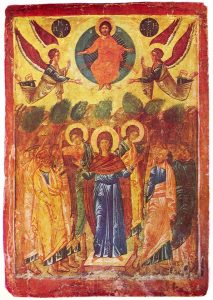 The ascension of our Lord into glory is the seal on his resurrection. Jesus taught Nicodemus, “No one has gone up to heaven except the one who has come down from heaven, the Son of Man” (John 3:13). St. Paul further explains that the ascension is the sign of his victory over the Hades, the kingdom of death, “What does ‘he ascended’ mean except that he also descended into the lower regions of the earth? The one who descended is also the one who ascended far above all the heavens, that he might fill all things” (Ephesians 4:9-10).
The ascension of our Lord into glory is the seal on his resurrection. Jesus taught Nicodemus, “No one has gone up to heaven except the one who has come down from heaven, the Son of Man” (John 3:13). St. Paul further explains that the ascension is the sign of his victory over the Hades, the kingdom of death, “What does ‘he ascended’ mean except that he also descended into the lower regions of the earth? The one who descended is also the one who ascended far above all the heavens, that he might fill all things” (Ephesians 4:9-10).
As God, the Lord does not change, for he reigns with his Father in glory forever. But in the ascension, Jesus in his human nature, one person as the Word of God and Son of God and incarnate man, lifts up our human nature to the right hand of the Father in the hope of life and deification. St. John tells us of this hope, “Beloved, we are God’s children now; what we shall be has not yet been revealed. We do know that when it is revealed we shall be like him, for we shall see him as he is” (1 John 3:2-3).
The liturgy of the Church teaches us the same mystery, “Ascending in glory today from the Mount of Olives, through your great love, you lifted up our fallen nature and enthroned it with the father on high” (Vespers). This was done out of love for us, “Having so loved human nature, you granted that it may be enthroned with you. In your compassion you united it with yourself, in union with it you have suffered, and by your passion you glorified it, O God, beyond all suffering” (Vespers).
Meditation by Archpriest David Petras